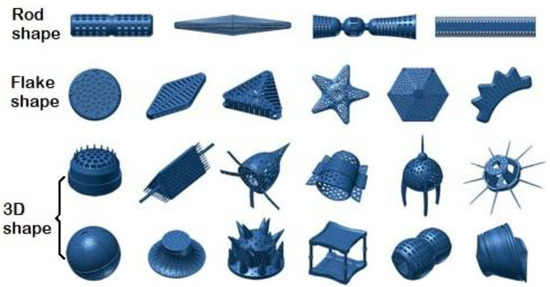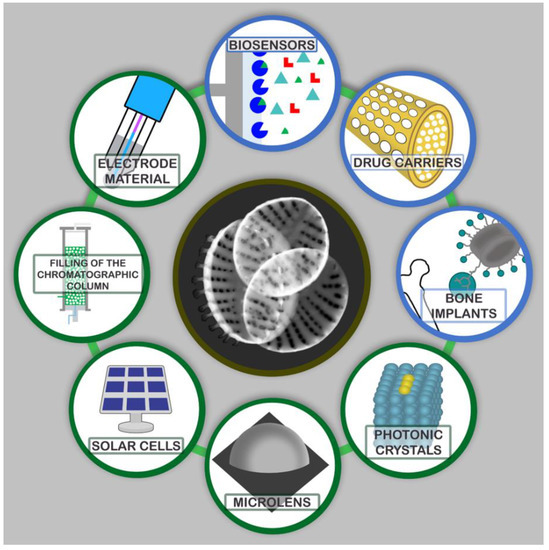Diatoms have an ability that is unique among the unicellular photoautotrophic organisms to synthesize an intricately ornamented siliceous (biosilica) exoskeleton with an ordered, hierarchical, three-dimensional structure on a micro- to nanoscale. The unique morphological, structural, mechanical, transport, photonic, and optoelectronic properties of diatomaceous biosilica make it a desirable material for modern technologies. This review presents a summary and discussion of published research on the metabolic insertion of chemical elements with specific functional activity into diatom biosilica. Included in the review is research on innovation in methods of synthesis of a new generation of functional siliceous materials, where the synthesis process is “outsourced” to intelligent microorganisms, referred to here as microtechnologists, by providing them with appropriate conditions and reagents.
- diatoms
- diatomaceous biosilica
- metal doping
- metabolic inserting
1. Introduction
The use of microorganisms, especially unicellular microalgae, is a novel approach in the design and synthesis of new inorganic composite nanomaterials [1][2]. Some microorganisms have the ability to synthesize unique mineral composites with complex, hierarchical structures on a micro- to nanoscale [3]. The single-celled photoautotrophic microorganisms—diatoms (Bacillariophyceae)—have an astonishing variety of intricately ornamented siliceous exoskeletons, called frustules or valves, with a unique three-dimensional structure (
The use of microorganisms, especially unicellular microalgae, is a novel approach in the design and synthesis of new inorganic composite nanomaterials [1,2]. Some microorganisms have the ability to synthesize unique mineral composites with complex, hierarchical structures on a micro- to nanoscale [3]. The single-celled photoautotrophic microorganisms—diatoms (Bacillariophyceae)—have an astonishing variety of intricately ornamented siliceous exoskeletons, called frustules or valves, with a unique three-dimensional structure (Figure 1 [4]) in more than 100,000 known species [5]. Such a variety of unique, precise siliceous structures with orderly pore (areola) systems makes them a desirable material for modern technologies [6][7][8][9][10][11][12][13][14].
[4]) in more than 100,000 known species [5]. Such a variety of unique, precise siliceous structures with orderly pore (areola) systems makes them a desirable material for modern technologies [6,7,8,9,10,11,12,13,14].
The concept of using diatomaceous biosilica as an implementation material in modern technologies, especially in nanotechnology, is relative new and was proposed in 1994 by Gordon R. and Drum R. W. [15]. Since then, the phenomenal ability of diatoms to synthesize unique three-dimensional structures with specific physicochemical (optical, electrical, filtration, thermal, mechanical) properties from amorphous silica has held growing fascination for biologists, chemists, and physicists [6][16][17][18][19][20][21]. Currently, diatomaceous biosilica, due to its three-dimensional, porous structure, wide availability, and the possibility of biosynthesis through the cultivation of diatoms under artificial conditions, is one of the most frequently used substitutes for mesoporous silica materials in modern technologies. These materials, despite their biocompatibility and large specific surface area [22], are difficult to synthesize because of the necessity of considerable financial input, a large amount of energy, and an association of toxic materials using [23].
The concept of using diatomaceous biosilica as an implementation material in modern technologies, especially in nanotechnology, is relative new and was proposed in 1994 by Gordon R. and Drum R. W. [15]. Since then, the phenomenal ability of diatoms to synthesize unique three-dimensional structures with specific physicochemical (optical, electrical, filtration, thermal, mechanical) properties from amorphous silica has held growing fascination for biologists, chemists, and physicists [6,16,17,18,19,20,21]. Currently, diatomaceous biosilica, due to its three-dimensional, porous structure, wide availability, and the possibility of biosynthesis through the cultivation of diatoms under artificial conditions, is one of the most frequently used substitutes for mesoporous silica materials in modern technologies. These materials, despite their biocompatibility and large specific surface area [22], are difficult to synthesize because of the necessity of considerable financial input, a large amount of energy, and an association of toxic materials using [23].The unique, hierarchically porous 3D structure of diatom frustules makes them an attractive source of solutions for the development of modern material engineering. There are a wide range of possibilities for the use of such materials, e.g., in the production of biosensors, optical devices, catalysts, semiconductors, effective adsorbents, templates for nanolithography, and in designing drug carriers or bone implants [6][11][17][18][20][23][24][25]. The range of perspectives for the use of diatomaceous biosilica is shown in
The unique, hierarchically porous 3D structure of diatom frustules makes them an attractive source of solutions for the development of modern material engineering. There are a wide range of possibilities for the use of such materials, e.g., in the production of biosensors, optical devices, catalysts, semiconductors, effective adsorbents, templates for nanolithography, and in designing drug carriers or bone implants [6,11,17,18,20,23,24,25]. The range of perspectives for the use of diatomaceous biosilica is shown in .
Figure 2. A range of possibilities to use diatomaceous biosilica.
A range of possibilities to use diatomaceous biosilica.2. Application
Diatomaceous biosilica can be successfully used as an electrode material for energy generation and storage, or as photonic crystals [26][27][28][29][30][31]. Diatom frustules can be used as microlenses, as they are able to focus light below the diffraction limit, and their ability to accumulate high-intensity light can lead to the development of modern solar cells [32][33][34][35][36]. High thermal and mechanical resistance as well as unique optical properties make diatomaceous biosilica an inspiration in the development of modern optoelectronic devices [23][24][30][37]. However, many of the possible applications for diatomaceous biosilica as an industrial material are limited by the chemistry of the silica in diatom frustules. For this reason, considerable efforts have been made recently to modify the structure of diatom frustules to make them more technologically functional, whilst preserving their unique shape and morphology [23][33][38][39][40][41][42]. An extremely exciting proposal for the modification of biosilica is its reduction to pure silicon, without destroying its three-dimensional structure, which would be associated with new, broad possibilities in the field of microelectronics [18][38]. Promising results have been obtained using diatomaceous biosilica as a matrix in the chemical synthesis of nanomaterials [20][27][43][44]. Umernura et al. [41] proposed using fragmented diatomaceous biosilica as a matrix for luminescence in the liquid phase. The potential for placing specific proteins, enzymes, or antibodies within the structure of diatoms could allow for the production of microchip-sized hybrid biosensors, which would be a medical breakthrough [16][18][45].
Diatomaceous biosilica can be successfully used as an electrode material for energy generation and storage, or as photonic crystals [26,27,28,29,30,31]. Diatom frustules can be used as microlenses, as they are able to focus light below the diffraction limit, and their ability to accumulate high-intensity light can lead to the development of modern solar cells [32,33,34,35,36]. High thermal and mechanical resistance as well as unique optical properties make diatomaceous biosilica an inspiration in the development of modern optoelectronic devices [23,24,30,37]. However, many of the possible applications for diatomaceous biosilica as an industrial material are limited by the chemistry of the silica in diatom frustules. For this reason, considerable efforts have been made recently to modify the structure of diatom frustules to make them more technologically functional, whilst preserving their unique shape and morphology [23,33,38,39,40,41,42]. An extremely exciting proposal for the modification of biosilica is its reduction to pure silicon, without destroying its three-dimensional structure, which would be associated with new, broad possibilities in the field of microelectronics [18,38]. Promising results have been obtained using diatomaceous biosilica as a matrix in the chemical synthesis of nanomaterials [20,27,43,44]. Umernura et al. [41] proposed using fragmented diatomaceous biosilica as a matrix for luminescence in the liquid phase. The potential for placing specific proteins, enzymes, or antibodies within the structure of diatoms could allow for the production of microchip-sized hybrid biosensors, which would be a medical breakthrough [16,18,45].Test results so far have indicated a great potential for the application of diatomaceous biosilica as a component of solar cells, in place of expensive titanium dioxide [37][46][47][48]. An extremely interesting but not yet fully developed idea is the ability to modify the structure of diatomaceous biosilica. There are two basic methods for the functionalization of diatoms [49]. The first one is the in vitro method involving the attachment, via a condensation reaction, of functional groups on the surface of the diatomaceous frustule after its purification, i.e., the removal of the organic matrix of the diatomaceous cell. The second one is the in vivo method based on the stable incorporation of the modifying element into the nanostructural architecture of diatomaceous biosilica during cultivation [50]. The in vitro method can be used to give magnetic properties to diatom frustules by adding iron nanoparticles treated with dopamine [51], as well as to create antibody matrices that can be applied in such techniques as immunoprecipitation [27]. The functionalization of diatoms in vivo is possible when modifying elements are added to the culture medium. This enables the incorporation of the doping element into the structure of the diatom frustules. So far, a few publications report the ability of diatoms to metabolically introduce metal oxides such as titanium or germanium into the structure of silica frustules [3][19][52][53][54][55][56][57][58][59][60][61][62]. There are also results of initial studies on the possibility of metabolic substitution of silicon atoms with nickel, zirconium, tin, zinc, calcium, aluminum, iron, and europium in diatomaceous biosilica [19][63][64][65][66][67][68][69][70][71].
In this review we summarize and discuss the research published to date on the metabolic insertion of chemical elements with specific functional activity (metals or semimetals) into the diatomaceous biosilica structure. Attention is drawn to the culture conditions (culture medium, type of salt and concentration range of admixed elements, pH), physicochemical properties of the biosilica obtained, the amount embedded and distribution of the element in the biosilica structure, and prospects for the use of the doped biosilica. We hope this work will encourage interest in metabolic insertion as a novel and innovative approach to the synthesis of new materials, where the synthesis itself is “outsourced” to the microorganisms as “microtechnologists” who need only the appropriate conditions and reagents.